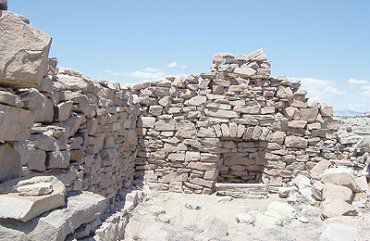The Emery County Historical Society recently went on a trek out on the desert. They visited the old silver and copper mines of the Summerville Mining District of Emery County, the site of the old Buckhorn Flat Railroad and the Buckhorn Flat area once known as the Morrison-Knudson Shanty Town.
The Summerville Mining District was established in 1883 in the area between Woodside and Cedar Mountain where a few small veins carrying gold, silver, copper, and lead occurred.
Between 1900 to 1920, the Summerville Mining district east of Cedar Mountain continued to be the site of much activity but only limited lead, zinc, and silver production.
In 1967 it was reported that the extent and quality of gold, silver, and copper reserves in the Summerville Mining District was largely unknown and the ore was in small deposits and gave little promise of further development under its present condition.
The Summerville Wash has several branches and all of them produce silver, but on the upper reaches of one of the branches silver ore was found in place. Here the Summerville Mines were started, and rumor has it a town was started. The town of Summerville was originally a tent town scattered over a wide area. There were very few stone buildings and one small stone store.
There is no record of when the town first came into existence but by 1899 supposedly it had a population of more than 500 people.
The Denver and Rio Grande Railroad began extending its narrow-guage line through Emery County in 1880. The plan was to go from Green River through Cottonwood wash and Buckhorn Flat to Castle Valley Junction, located in the Hadden Flat area east of Huntington, here the railroad would divide, with one branch going south through Castle Valley and up Salina Canyon, and the other going north through Price Canyon.
Construction on the railroad bed began early in April of 1881 and was abandoned on the last of December of 1881.
In 1882 railroad ties were cut in Tie Fork Canyon west of Huntington, then they floated the ties down Huntington Creek, it was one of the most adventurous chapters in Emery County’s History. The ties were floated for 20 miles down Huntington Canyon around the bend in the creek north- east of Huntington then south to Lawrence where they were fished out of the creek. The tie business only lasted one year, the railroad line through the Buckhorn Flat was abandoned. The railroad was switched and went north of Buckhorn Flat through Woodside to Price.
Rumor has it that in 1881 an English cook working on the railroad grade wanted to get back to England, so he put all his money in a coffee can to save it for his trip expenses.
He hid the can in the rocks for safe keeping, but before his trip to England he had an appendicitis attack. The workers put him in a buckboard and started for the hospital in Price. Somewhere in the Cleveland area the appendix ruptured and the English man died. To this day the coffee can of money is still hidden along the Old railroad grade in the Chimney Rock area.
In 1948 the Morrison-Knudson Company began tunneling in the Buckhorn Flat area with a sizable crew, some of the crew were housed in the temporary structures on this site, while others lived in Huntington and Castle Dale.
The Morrison-Knudson shanty town consisted of a bunkhouse and eating quarters, a bathhouse, a commissary and a darkroom, and five tar paper shanties, with a large water storage tank on the hill above the village. Water used for drilling was hauled from the Buckhorn Well.
The Morrison-Knudson project was completed in 1952 with the detonation of some 320,000 pounds of high explosives.
Historical society makes trek to desert

"The inside of a stone cabin with the fireplace intact."
